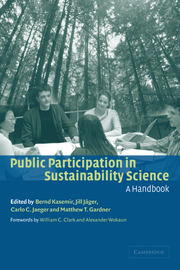Book contents
- Frontmatter
- Contents
- Notes on contributors
- Foreword: science, participation, and sustainability
- Foreword: sustainability, energy use, and public participation
- Preface
- Acknowledgments
- Part I Concepts and insights
- Part II Experiences with IA Focus Groups
- Part III Further forms of participation
- Part IV Future perspectives
- References
- Index
Foreword: science, participation, and sustainability
Published online by Cambridge University Press: 22 September 2009
- Frontmatter
- Contents
- Notes on contributors
- Foreword: science, participation, and sustainability
- Foreword: sustainability, energy use, and public participation
- Preface
- Acknowledgments
- Part I Concepts and insights
- Part II Experiences with IA Focus Groups
- Part III Further forms of participation
- Part IV Future perspectives
- References
- Index
Summary
This book reports the results of a grand experiment in how lay publics might be more effectively engaged in linking science and technology to the quest for sustainable development.
The experiment integrates three long-established but usually isolated lines of thought. The first concerns the appropriate role of science and technology in a transition toward sustainability. Early thinking on sustainability – such as that articulated in the World Conservation Strategy of 1980 – relied heavily on scientific studies of renewable resource management, carrying capacities, and environmental limits. The Brundtland Commission's 1987 report “Our Common Future” properly stressed the importance for any sustainable development strategy of targeted investments in knowledge creation and application. Over the subsequent decade, however, such investments generally lagged far behind needs. It has only been in the context of discussions surrounding the 2002 World Summit on Sustainable Development that widespread attention has begun to return to securing the scientific and technological foundations for a transition toward sustainability. One of the exceptions to this general trend has been in the relatively well-supported problem of climate change addressed in the study reported here. Climate change is, of course, only one aspect of the overall sustainability challenge. It none the less incorporates many of the most formidable elements of that challenge: tight coupling between social and environmental systems across multiple spatial scales; complexity in the resulting interactions that makes counterintuitive surprise the norm; and sufficiently long time lags between interventions and consequences to make wait-and-see management an option only for ostriches.
- Type
- Chapter
- Information
- Public Participation in Sustainability ScienceA Handbook, pp. xvii - xixPublisher: Cambridge University PressPrint publication year: 2003

